Royal Connection. Amazing pieces of royal jewellery
Written by Peter le Rossignol
What if you could enter a real treasure trove filled with the most amazing royal jewellery, glittering gems, diamonds and pearls, all in one place? Take a moment and let our Jewellery and Precious Stones Specialist guide you through the World’s most exquisite and famous pieces ever made!
The nine major stones cut from the rough Cullinan diamond. Top: Cullinans II, I and III. Bottom: Cullinans VI, VIII, IV, V, VII and IX. Image: Wikipedia / Public Domain
Pearls and diamonds have in previous centuries been the gems of royalty and the aristocracy being the symbols of wealth and power. Possibly the finest collection on public display of these magnificent gems are the crown jewels of England housed in the Tower of London.
Royal Jewels- a brief history
The majority of the gems are in historical terms of recent acquisition mainly in the 18th and 19th centuries. In the middle of the 17th century the English Civil War broke out, caused by an illegal tax raise by King Charles I to which Parliament opposed. The war concluded with the execution of the King in January 1649. The leader of the Parliamentarians, Oliver Cromwell, became Lord Protector of England and after his death in 1660, Charles II was restored to the throne having been in exile on the Continent. This period in English history is called interregnum and during this time Oliver Cromwell disposed of the original crown jewels. Upon the restoration of the monarchy in 1660 the present collection was assembled and added to throughout the ensuing years culminating in the addition of the Cullinan stones in the early 20th century.
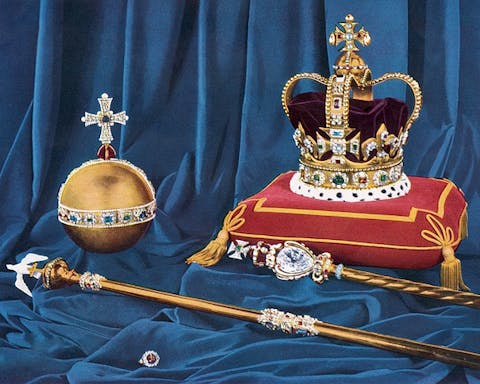
Crown Jewels of United Kingdom: St Edward's Crown, and the sovereign's orb, sceptres and ring. Image: Wikipedia / Public Domain
Cullinan stones and the royal regalia
The Cullinan rough diamond when discovered weighed over three thousand carats and was cut into 9 stones. The largest of is so called Cullinan 1, is of the pear cut, weighs 530 carats and is the largest colourless diamond in the world. It is mounted in the sovereign’s sceptre.
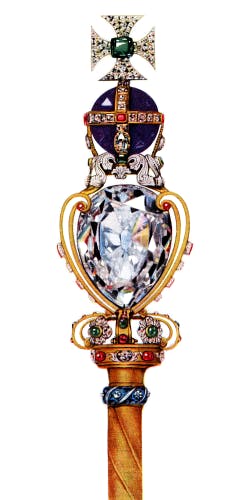
Head of the Sovereign's Sceptre with Cross, showing the Cullinan I diamond. Image: Wikipedia / Public Domain
Many of the historical gems were reacquired after the restoration and are set in various parts of the regalia. St. Edward’s crown, which weighs five pounds (imperial) is only used during the coronation ceremony. For the rest of the monarch’s reign for such occasions as the opening of parliament the Imperial, the State Crown is used. Cullinan 2 and the Black Prince’s ruby, together with the Stuart and Edward the Confessor’s sapphires are amongst the most well-known gems set in this crown together with a pair of drop pearls which are allegedly the earrings from the collection of Elizabeth I. The majority of diamonds and coloured gem stones originate, until the mid 19th century, from Indian, Ceylon, Burma and South America, the latter especially for emeralds and diamond after the Spanish conquests.
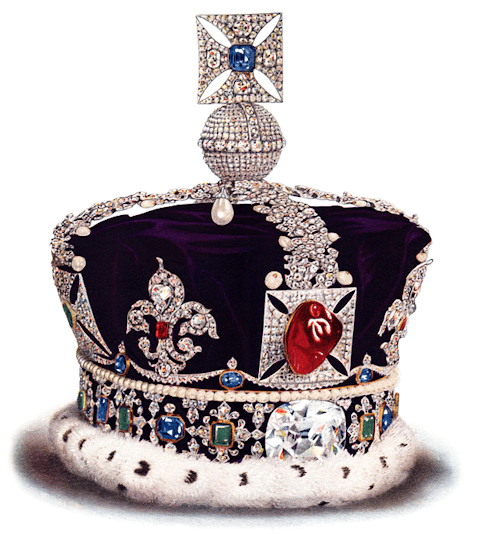
Imperial State Crown of the United Kingdom. Image: WIkipedia / Public Domain
Pearls in the royal jewellery collection
Included in the State jewels of England are the two single rows of pearls that belonged to Queen Anne (died 1715); these are natural pearls still in use today which in itself is a testament to their durability. In today's world the majority of pearls are cultured, freshwater or simulated. The latter should not be dismissed readily as in the late Tudor and Stuart periods 1500-1715 simulated pearls abound including the Duchess of Richmond’s earrings and necklace worn on the occasion of Charles II coronation (on display at Westminster Abbey Museum)
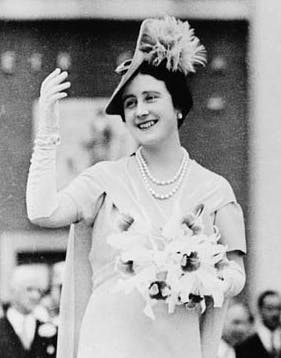
Queen Elizabeth (later the Queen Mother) wearing the Queen Anne and Queen Caroline pearls, 1939. Image: Wikipedia / Public DOmain
Natural pearls were dived for and over a period of time after matching size and colour, which could take many months or years, produced a necklace; in exceptional cases large individual pearls were made into exquisite items of jewellery. A wonderful example was the three hundred and thirty seven grain egg shaped pearl in the French crown jewels which, after the revolution, was in private hands and sold in the 20th century, remounted by Cartier and sold again in the 21st century in the Elizabeth Taylor auction. The majority of these gems originated in the Persian Gulf area, however some were discovered in the South Seas and in the seas around Java.
Personal Jewels of Queen of England
The other royal houses of Europe in the 17th, 18th, 19th and some in the 20th century all have collections of magnificent jewels which do go on display in Palaces or Museums, however as cited above the finest extant collection is in the United Kingdom. The personal jewels of the Queen are impressive and many of the historical items include the magnificent sapphire and diamond oval brooch presented to Queen Victoria the day before their wedding (Sunday 9th February 1840) by Prince Albert.
Queen Victoria’s diamond necklace
The diamond collarette necklace that was made for Queen Victoria is worn normally for the opening of Parliament or other State occasions is a single row of old cut diamonds with a pear cut drop centre; weight of stones 161 carats in total.
Check out the latest Fine Jewellery Auctions on Barnebys here!

Queen Victoria (1819–1901) wearing diamond colarette necklace, 1882. Image: Alessandro Bassano /Public Domain
There are also numerous items in the Royal collection that came as presents and tributes from the then colonies. Among these are the Timur ruby (352 carats) known as the “Tribute to the World”, and a famous gem known as Koh-i-noor. The diamond’s story goes back 5,000 years, when a Persian Emperor gave it the name “Mountain of Light”. This beautiful gem, recut in the 19th century, now sits in the Queen Mother’s crown on show at the Tower of London. Amongst the gifts received in the 19th century is the Queen Victoria Jubilee necklace and brooch presented by the government of the day on behalf of the people which are a favourite and worn often by the present Queen. The necklace has graduated pearl and diamond trefoil clusters leading to a central quatrefoil cluster, surmounted with a crown, and the centerpiece has a diamond mounted drop pearl beneath. (image)
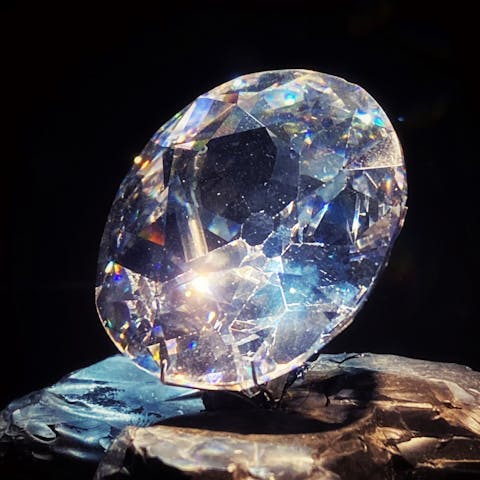
Replica of the Koh-i-Noor diamond at Prince of Wales Museum of Western India, Mumbai: Image: Aiva / License CC BY 2.0
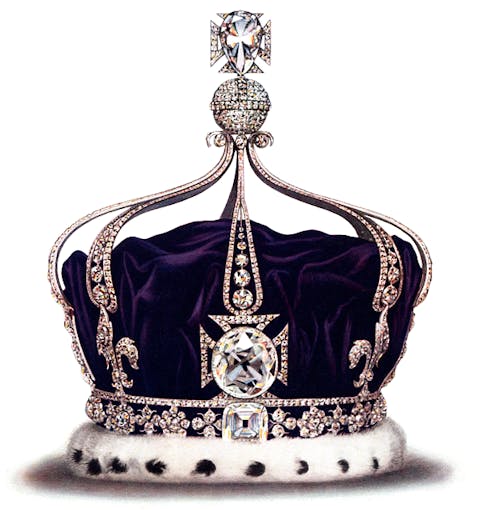
The Koh-i-Noor diamond in the front cross of Queen Mary's Crown. Image: Wikipedia / Public Domain
Williamson Diamond
In more modern times our present Queen was presented with a 24 carat pink diamond, known as the Williamson which is named after the mine owner who discovered the stone, and this is mounted as the centre stone of a magnificent brooch in the form of a jonquil flower.
Grand Duchess Vladimir Tiara
The Queen’s most familiar tiara is of the diamond looped design, with pearl drops in the loops, the latter can be substituted with the Cambridge emeralds. The tiara was originally owned by the Grand Duchess Vladimir of Russia. During her escape from the Russian Revolution (1917-1923), her jewels were walled up in a safe in her St. Petersburg Palace. A young English aristocrat smuggled himself into Russia and brought out the tiara and other jewels in two battered Gladstone bags. The tiara was sold to Queen Mary, wife of King George V.
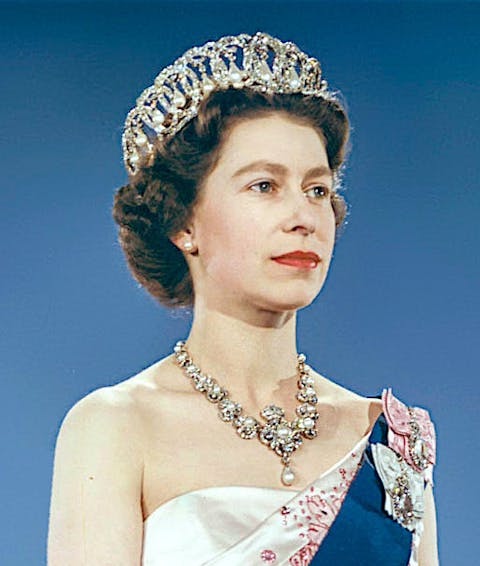
Queen Elizabeth II wearing the Vladimir Tiara, the Queen Victoria Jubilee Necklace, Image: Library and Archives Canada / License: CC BY 2.0
The Russian royal house owned a huge collection of fabulous jewels, many of which were sold by the revolutionaries in the 1920s and these, with other ancestral jewels, appear on the market from time to time. The attribution of these items is paramount as with the passing of years, a family story is embellished; the origin of an item can enhance the value especially from a royal collection, however “caveat emptor” (buyer beware) rule applies. The only gems with an English royal provenance to be sold are those of the Duchess of Windsor who was married after the abdication to Edward VIII, the so-called uncrowned king.
Collecting and using antique jewellery
Collecting or accumulating antique jewels from family or friends can be rewarding both in monetary and historical terms, and the research into where and how an item was made is both fascinating and satisfying. In the 19th century gold and silver were the only two precious metals. The mounts for gem set items were manufactured in these two metals, silver around the stones with gold backs, or, in the case of rings, gold shanks and silver for the stones. When collecting older jewellery, it is always prudent to check for any repair work, as some provincial craftsmen were not averse to using lead solder which can cause serious damage to the piece, as the lead if reheated can eat into the gold or silver. Modern additions or replacement pieces are also a problem, and will have an affect on the value of the piece.
Jewellery and tradition across the world
People across the globe use ancient or older items of jewellery at their weddings and in the West it is traditional to wear something borrowed and something blue which in many cases appears to be a piece of family jewellery. In the aristocratic families, the family tiara and other jewels are very often on display and this is replicated in paste jewellery. This practice was very popular in the 19th century and some items of this period are beautifully made. The paste stones were set in silver with highly polished foil backs in the settings which gave extra impetus to the light refraction and from a distance appeared to be “diamonds”. Paste items were often taken when travelling and as such the owners were not too distraught if they were appropriated. Paste jewels of the 19th century, in good condition, have become very desirable and as such have seen a steady climb in their value.
Related: Learn about costume jewellery
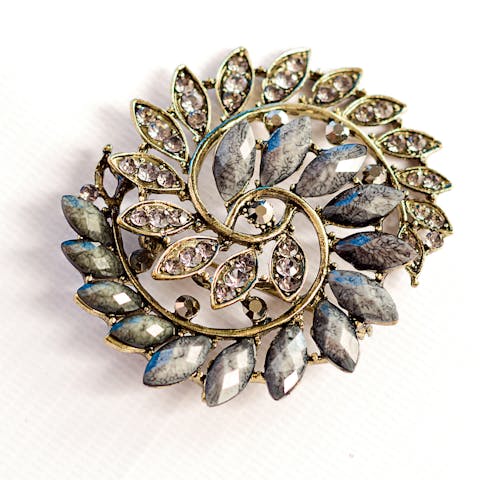
Vintage paste stone brooch, Image: Canva /Public Domain
In middle Eastern countries it is gold jewellery that is popular with brides and represents part of the dowry and the opulence of these items vary depending upon the wealth of the individuals. The Maharajas for instance were bedecked in pearls, diamonds, rubies and emeralds of the most spectacular variety.
Amongst the finest stones coming from the Middle East the Pitt diamond, a 140.5 carats that was eventually sold to Phillipe II Duke of Orleans in about 1717. The name Pitt refers to Thomas Pitt (1653-1726), a long serving employee of the East India Company. The diamond after sale became known as the Regent.
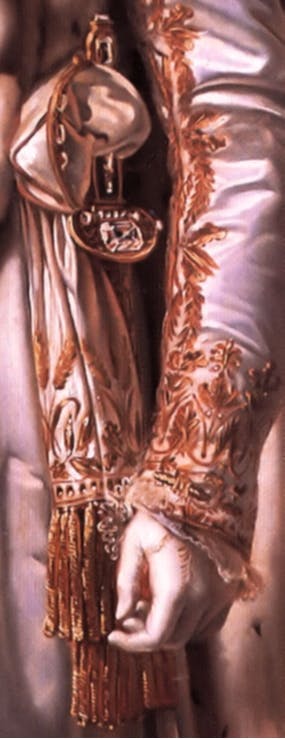
Regent diamond mounted to the Napoleon Bonaparte's sword. Details from the portrait "Napoleon in Coronation Robes" by François Pascal Simon Gérard, 1805. Image: Wikipedia / Public Domain
Carved emeralds, sapphires, rubies and diamonds were brought by the Maharajas to Europe in the late 19th early 20th century and mounted into all manner of jewellery for potential brides and wives to wear, many of the famous French jewellers Cartier, Boucheron, Chaumet and Van Cleef and Arpel all made items of jewellery from these stones and these appear on the market today.
In the Far East gold wares are offered as dowry and together with jewellery represent a bridal gift of great importance. Jade is referred to in China as The Stone of Heaven and has a very special meaning to their culture, it is always a great honour to receive a piece of jade. The Emperors of ancient China venerated the stone and especially in the 18th century under the Emperor Qianlong 1736-1795. Gold and jade are still today respected as the finest of gifts.
Related: The meaning of Jade

Jade necklace mounted in gold chain. Image: Tim Evansson / CC BY-SA 2.0
Peter le Rossignol has finished two Master degrees in History of Art and Historical Interiors and English and French decorative art 1169-1820. He also holds a PhD. in Precious Metal Technology. He started his career with training in London company who worked closely with such clients as Garrards, Asprey, Collingwood, Tiffany, Cartier. For the past forty years he has been an independent advisor for his clients in the categories of jewellery, silverware, oriental decorative art and fine porcelain. He is also a Fellow of the Society of Antiqueries in London.

